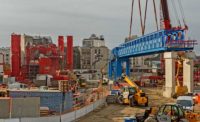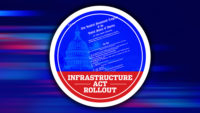Since the world's first passenger train service started in northern England nearly 200 years ago, the U.K.'s railroads have inherited more than 19,000 miles of tracks, which are increasingly being stressed by unprecedented temperature variations and rainfall. For the next five years, the infrastructure owner, Network Rail, plans to spend $3.5 billion on the system's resilience.
“Climate change is the biggest challenge our railway faces," said NR's chief executive, Andrew Haines, announcing the state-owned company's $57-billion five-year total spending plan to 2029. The "unprecedented" battering from 14 named storms to hit the U.K. last year "has taken its toll on our railway with experts predicting more of the same to come."
Covering new work and maintenance, the climate resilience spending will focus on earthworks stability at some 20,000 embankments and cuttings with improved drainage and better monitoring.
As well as predictive and monitoring technology, NR will train hundreds of key staff at the Weather Academy it set up in 2022 with the national meteorological service, Newcastle University and the consultant MetDesk Ltd.
Following a period of record-breaking high temperatures, NR in summer 2022 established an extreme weather resilience task force of independent experts including a veteran civil engineer and a climatologist.
With a heritage going back to the September 1825 launch of the 26-mile Stockton and Darlington Railway, NR now "demonstrates a relatively high maturity in climate resilient planning in comparison to other rail operators internationally, and other sectors," according to an assessment for the government's Office of Rail and Road.
Since the government's Climate Change Act 2008, NR has tracked its work on climate resilience in reports for the Department for Environment Food and Rural Affairs. NR's most recent report noted a "step change" in its efforts following a 2020 Scottish train derailment on the Aberdeen to Glasgow line.
That August, a train went off the track, hitting a bridge and causing three deaths. In three hours before the accident, a month's worth of rain had washed out debris from a drainage trench onto the track, according to investigators.
The drainage system was later found to be poorly built, but still the accident revealed "how disruptive and potentially dangerous Britain’s volatile weather can be," noted Simon French, Chief Inspector of Rail Accidents, at the time. “The railway industry needs to think through the implications of severe weather on its infrastructure.”






Post a comment to this article
Report Abusive Comment